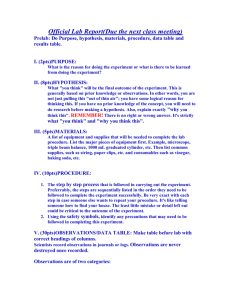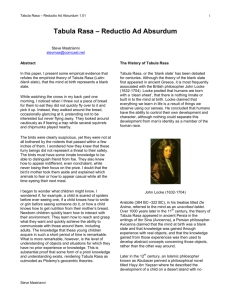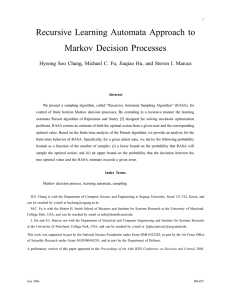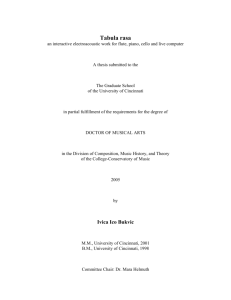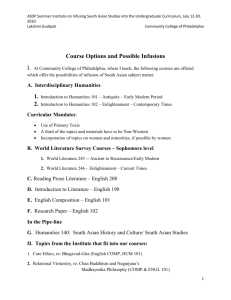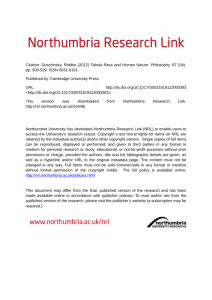Assumptions and Approaches of Linguistics
advertisement
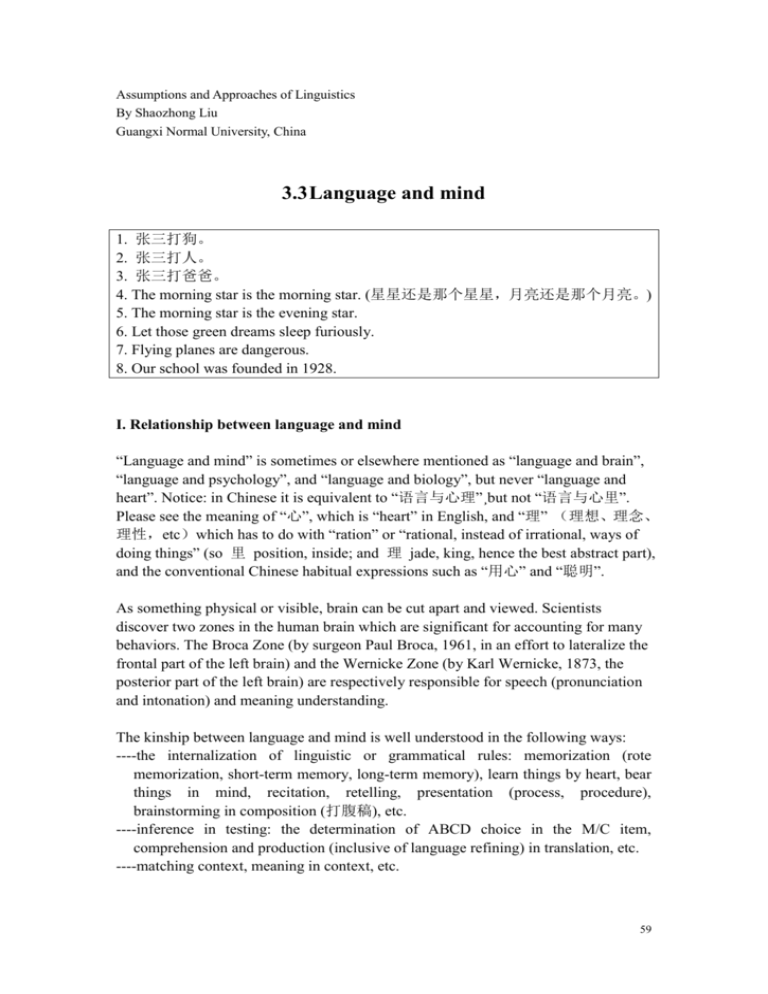
Assumptions and Approaches of Linguistics By Shaozhong Liu Guangxi Normal University, China 3.3 Language and mind 1. 张三打狗。 2. 张三打人。 3. 张三打爸爸。 4. The morning star is the morning star. (星星还是那个星星,月亮还是那个月亮。) 5. The morning star is the evening star. 6. Let those green dreams sleep furiously. 7. Flying planes are dangerous. 8. Our school was founded in 1928. I. Relationship between language and mind “Language and mind” is sometimes or elsewhere mentioned as “language and brain”, “language and psychology”, and “language and biology”, but never “language and heart”. Notice: in Chinese it is equivalent to “语言与心理”¸but not “语言与心里”. Please see the meaning of “心”, which is “heart” in English, and “理” (理想、理念、 理性,etc)which has to do with “ration” or “rational, instead of irrational, ways of doing things” (so 里 position, inside; and 理 jade, king, hence the best abstract part), and the conventional Chinese habitual expressions such as “用心” and “聪明”. As something physical or visible, brain can be cut apart and viewed. Scientists discover two zones in the human brain which are significant for accounting for many behaviors. The Broca Zone (by surgeon Paul Broca, 1961, in an effort to lateralize the frontal part of the left brain) and the Wernicke Zone (by Karl Wernicke, 1873, the posterior part of the left brain) are respectively responsible for speech (pronunciation and intonation) and meaning understanding. The kinship between language and mind is well understood in the following ways: ----the internalization of linguistic or grammatical rules: memorization (rote memorization, short-term memory, long-term memory), learn things by heart, bear things in mind, recitation, retelling, presentation (process, procedure), brainstorming in composition (打腹稿), etc. ----inference in testing: the determination of ABCD choice in the M/C item, comprehension and production (inclusive of language refining) in translation, etc. ----matching context, meaning in context, etc. 59 II. Referent One: the computer and our brain ----To see how our brain works, computer is used to simulate language computation; space or memory size; compartmentalization f-disk the “brain” (CPU) and directory. ----A handful of gray stuff with milliard or network of nerves; NOTHING is there, so tabula rasa hypothesis seemingly supported. ----Reflection in language learning: “stimulus-response-imitation-reinforcement” process in learning (the Behaviorist as Skinner) ----Implications: 1) scientific use of the brain; 2) scientifically study III. Referent Two: stages of linguistic development in children (please compare with M.A.K. Halliday’s functional stages in both children and adults) ----Stage 1: the one word stage, or holophrase stage, around the age of a year. Eg.: milk =I want milk. ----Stage 2: two-word stage, near the second birthday. Eg.: baby car (pointing to a toy car, meaning: This is the baby’s car. Similarly: baby dress, no shoe, no wash. ----Stage 3: developing stage, or the telegram stage, between two and a half and three years old. Eg: Put doll table, There Mommy shoe. ----Stage 4: near-adult grammar, between three and five years of age. Eg.: I see you sit down, I show you the ball I got. ----Stage 5: full competence, by late childhood. Eg.: near native syntactic devices, sufficient performance skills to understand and produce ordinary language. ----Implications: Teach along the line of cognitive development; from little to much, from easy to difficult, from errors to correctness, from correctness to appropriateness. Examples of mechanic transfer or drilling: 我不是东西;玛丽今 年七岁,她爷爷也七岁. IV. Referent Three: the evolutionary features of human beings in relation to their language learning (a biological foundation of learning) E. H. Lennerberg (1967): a biologically controlled (adult) behavior bears the following features: ----the behavior emerges before it is needed. ----Its appearance is not the result of a conscious decision. 60 ----Its emergence is not triggered by external events. ----There is likely to be a “critical period” for the acquisition of the behavior. ----Direct teaching and intensive practice have relatively little effect. (I’m sorry-I’m sorry, too—I’m sorry three—what’re you sorry for? I’m sorry five. Hence the teachability / learnability issue) ----There is a regular sequence of “milestone” as the behavior be correlated with age and other aspects of development. ----Implications: 1) be humanistic; 2) make full cognition and use of the human environments; 3) be pragmatic. V. The Tabula Rasa Hypothesis How do children acquire their first language? Some people believe that is not observable and that the infant’s mind at birth is a blank slate to be written on by experience. This is known as the Tabula Rasa Hypothesis and people holding this view are called behaviorist. With regard to language, they claim that children acquire their first language through a chain of “stimulus-response-imitation-reinforcement”. Mary: I am hungry. Peter: Here’s an apple. Mary: Thank you. Implications: More input! Practice. VI. The Innateness Hypothesis Other named the Chomsky Hypothesis. People of this creed are referred to as nativists 先天论者or mentalists 精神主义者. The Innateness Hypothesizers hold that human babies are somewhat predisposed to acquire a language. They believe that there are certain aspects of linguistic organization that are basic to the human brain and that makes it possible for human children to learn a language with all its complexity with little or no instruction from family or friends. For Chomsky, a child must be born with some sort of mechanisms which guides the child in his language acquisition. He assumes that the child is born with what he calls a language acquisition device (LAD), which he believes to consist of three elements: 1) linguistic universals (limited words/sentences of unlimited productivity; the UG / Windows OS, 2) a hypothesis make device, 3) and evaluation /testing procedure. Implications: 61 Make full use of the human brain; believe in the potential of man and make full use of its resources; examples: 有口不开浪费,有嘴不说浪费。 Encourage personal pursuits, personality development, individual wants, discrepancies and creativity. 成功才是成功之母。 62





